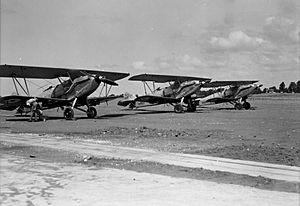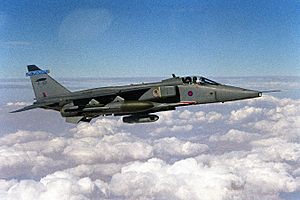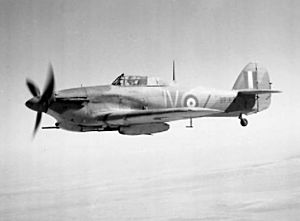No. 6 Squadron RAF facts for kids
Quick facts for kids No. 6 Squadron RAF |
|
|---|---|

Squadron badge
|
|
| Active | 31 January 1914 – 1 April 1918 (RFC) 1 April 1918 – 31 May 2007 (RAF) 6 September 2010 – present |
| Country | |
| Branch | |
| Type | Flying squadron |
| Role | Multi–role combat |
| Part of | No. 1 Group (Air Combat) |
| Home station | RAF Lossiemouth |
| Nickname(s) | 'The Flying Tin Openers' |
| Motto(s) | Oculi Exercitus (Latin for 'The eyes of the army') |
| Aircraft | Eurofighter Typhoon FGR.4 |
| Battle honours |
|
| Commanders | |
| Current commander |
Wing Commander N J Rees |
| Insignia | |
| Squadron tail badge |  |
| Squadron badge heraldry | An eagle, wings elevated, preying on a serpent. The use of the Royal Regiment of Artillery's red lightning bolt on a light background, was adopted in recognition of the squadron's close cooperation with the Royal Artillery during the First World War. The badge was approved by King George VI in January 1938. |
| Roundel |  |
| Aircraft codes | EA–EZ (Present) |
No. 6 Squadron, also known as 'The Flying Tin Openers', is a famous part of the Royal Air Force (RAF). They fly powerful Eurofighter Typhoon FGR.4 jets from RAF Lossiemouth in Scotland. This squadron has a long and exciting history, going back to 1914. They are special because they have two Royal Standards, which are like special flags, given to them for their long service.
Contents
History of No. 6 Squadron RAF
Early Years and World War I Missions

No. 6 Squadron was created on January 31, 1914. It started as part of the Royal Flying Corps (RFC) at Farnborough. Their first leader was Major John Becke.
The squadron began with a few Royal Aircraft Factory B.E.2s and Farmans. They even had a flight that used man-lifting kites! In October 1914, they flew across the English Channel. Their mission was to help stop the Germans from taking Antwerp.
In November, the squadron joined the RFC's 2nd Wing. Their job was to support the Second and Third Corps. This meant they helped ground troops by flying over battlefields.
Lanoe Hawker's Heroism
On July 25, 1915, Captain Lanoe Hawker showed incredible bravery. He attacked three German planes one after another. He fired all his bullets into the first plane, sending it spinning down.
His second victory saw a German plane forced to the ground, damaged. The third German plane, an Albatros C.I, burst into flames and crashed. For these amazing actions, he received the Victoria Cross, a very high award for bravery.
Between the World Wars

After World War I ended, the squadron moved to Iraq in July 1919. They used Bristol Fighters to help the army in Northern Iraq. Later, they got Fairey Gordon planes and became a bomber squadron. In 1935, these were replaced by Hawker Harts.
No. 6 Squadron in World War II
In 1938, the squadron moved to Palestine. They went back to helping the army, flying Hawker Hardys. They also added Gloster Gauntlets and Westland Lysanders to their fleet.
When Italy joined the war in June 1940, part of the squadron went to Egypt. They worked with the army there. From 1940 to 1943, the squadron flew special Hawker Hurricane Mk. IID planes. These planes had 40mm cannons and were used to attack tanks in the Western Desert. This earned them the nickname 'The Flying Tin Openers'.
In spring 1944, the squadron moved to Italy. They flew Hurricane Mk.IVs equipped with rockets. They attacked enemy ships in Yugoslav harbors and on the Dalmatian islands. These ships were supplying German forces. The squadron also used airfields in Corsica, Greece, and other parts of Italy. An extra fuel tank let their Hurricanes fly for almost three hours.
Post-War and Cold War Operations
In July 1945, the squadron moved back to Palestine. They worked with the police, patrolling the Kirkuk-to-Haifa oil pipeline. Their job was to prevent attacks. The squadron stayed in the Middle East until 1969.
During this time, they flew many different aircraft. They started with Hurricanes and a few Spitfires. Then they used Hawker Tempest Mk. VIs and later de Havilland Vampire FB.5s.
In January 1950, the squadron moved to RAF Habbaniya in Iraq. They moved between different bases in Iraq, the Suez Canal Zone, Cyprus, and Hashemite Kingdom of Jordan. On October 15, 1950, King Abdullah I of Jordan gave No. 6 Squadron a Royal Standard. This was to thank them for their long service in the Middle East since 1919.
The squadron kept flying Vampires and Gloster Meteor T.7s. In 1954, they switched to de Havilland Venom FB.1s and then FB.4s. In April 1956, they returned to Cyprus and flew from RAF Akrotiri. From there, they attacked Egyptian airfields during the Suez Crisis. In 1957, they started flying English Electric Canberras until 1969.

After 50 years outside the UK, the squadron returned in 1969. They were the first to get the Phantom FGR.2 at RAF Coningsby. In 1974, they switched to the Jaguar GR.1 and T.2 at RAF Lossiemouth. The squadron then moved to RAF Coltishall. They were ready for tactical nuclear missions until 1994, when this role ended.
Modern Operations
No. 6 Squadron stayed at RAF Coltishall until it closed in April 2006. Then they moved to RAF Coningsby. Their aircraft were sent to the Gulf for Operation Granby (the Gulf War). They also helped enforce the Northern No-Fly-Zone. From 1993, the squadron flew missions over Bosnia from Italy.
No. 6 Squadron was the last to fly the SEPECAT Jaguar. They were disbanded on May 31, 2007. The Eurofighter Typhoon was meant to replace the Jaguar. The RAF announced that No. 6 Squadron would be the fourth squadron to use the Typhoon.
The squadron officially reformed on September 6, 2010, at RAF Leuchars in Fife. New Typhoon aircraft arrived in the squadron's colors. In March 2011, they took over the Quick Reaction Alert role for northern UK. This means they are ready to launch quickly if needed.
In November 2011, four Typhoons from No. 6 Squadron flew to Malaysia. They took part in air exercises for the 40th anniversary of the Five Power Defence Arrangements. In August 2013, their Typhoons trained with HMS Dragon and US fighters in the Gulf. In June 2014, the squadron moved to its new home at RAF Lossiemouth.
The squadron took part in the 2018 missile strikes against Syria during the Syrian Civil War. In March 2020, the squadron received a special honor. They were allowed to add a battle honor to their standard. This recognized their role in Bosnia in 1995.
Aircraft Flown by No. 6 Squadron
No. 6 Squadron has flown many different types of aircraft throughout its long history. Here are some of them:
- Farman MF.7 "Long Horn" and MF.11 "Short Horn" (1914)
- Royal Aircraft Factory B.E.2 variants (1914)
- Royal Aircraft Factory R.E.8 (1918)
- Bristol Scout (1915)
- Bristol F2B "Brisfit" (to 1931)
- Fairey Gordon
- Gloster Gauntlet
- Hawker Hart (1935)
- Hawker Demon (1935)
- Hawker Hardy (1938)
- Westland Lysander
- Gloster Gladiator
- Hawker Hurricane (1941)
- Hawker Hurricane IID — Famous "Tankbusting" variant (1942–1944)
- Hawker Hurricane IV — Ground Attack variant (1944–1946)
- Bristol Blenheim
- Supermarine Spitfire (1946)
- Hawker Tempest (1946–1949)
- de Havilland Vampire (1949)
- de Havilland Venom FB.4
- English Electric Canberra B.2, B.15, B.16 (1957–1969)
- McDonnell Douglas F-4M Phantom FGR.2 (1969–1974)
- SEPECAT Jaguar GR.3 (1974–2007)
- Eurofighter Typhoon FGR.4 (2007 – present)
Images for kids
-
Two Eurofighter Typhoons FGR.4 of No. 6 Squadron carry Paveway II training rounds en route to the Cape Wrath range in Scotland during March 2013.
See also
- List of Royal Air Force aircraft squadrons



